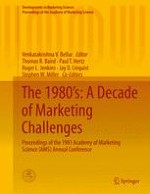This volume includes the full proceedings from the 1981 Academy of Marketing Science (AMS) Annual Conference held in Miami Beach, Florida with the theme The 1980’s: A Decade of Marketing Challenges. It provides a variety of quality research in the fields of marketing theory and practice in areas such as consumer behaviour, marketing management, marketing education, industrial marketing, and international marketing, among others.
Founded in 1971, the Academy of Marketing Science is an international organization dedicated to promoting timely explorations of phenomena related to the science of marketing in theory, research, and practice. Among its services to members and the community at large, the Academy offers conferences, congresses and symposia that attract delegates from around the world. Presentations from these events are published in this Proceedings series, which offers a comprehensive archive of volumes reflecting the evolution of the field. Volumes deliver cutting-edge research and insights, complimenting the Academy’s flagship journals, the Journal of the Academy of Marketing Science (JAMS) and AMS Review. Volumes are edited by leading scholars and practitioners across a wide range of subject areas in marketing science.
